Level Boarding - The What, Why and How.
By Ela
Posted: 18th June 2024. Last updated: 20th February 2025 (list changes)
This is part one of a small series I am writing about the state of the railways in the United Kingdom. The list below will be updated as time goes on and new parts get published. You can stay up to date with my research and progress by following me on Mastodon (historians.social).
- Level Boarding - The What, Why and How (You are here).
- Level Boarding - How Bad Is It?
Abstract
The passenger experience on the railways of the United Kingdom is an inaccessible one. Despite the existence of infrastructure standards dictating how and where platforms should be built, both the fixed infrastructure (platforms, the permanent way, etc.) and rolling stock (the trains) fail to provide a safe and equitable experience for passengers boarding and alighting trains. Large steps, wide gaps and the risk of falls are all hazards faced by passengers on a daily basis, sometimes with fatal consequences.
The railways of the United Kingdom are failing to improve the safety of one of the most dangerous parts for passengers. That's quite a bold statement to make, however it one that I believe to be true. This is not to say that there are places that are improving the situation, some in better ways than others. This is also not to say that the situation can't be improved. It can. The issue? The Platform-Train Interface (PTI).
What is the issue? Most passenger carrying vehicles in the fleets of UK train operators fundamentally do not fit the platforms that they serve. Further to this, many platforms they serve do not meet the specifications for a platform. Bold statements again, however by the end of this I think you will agree with me. First of all, let's look at some examples of where this is done right.
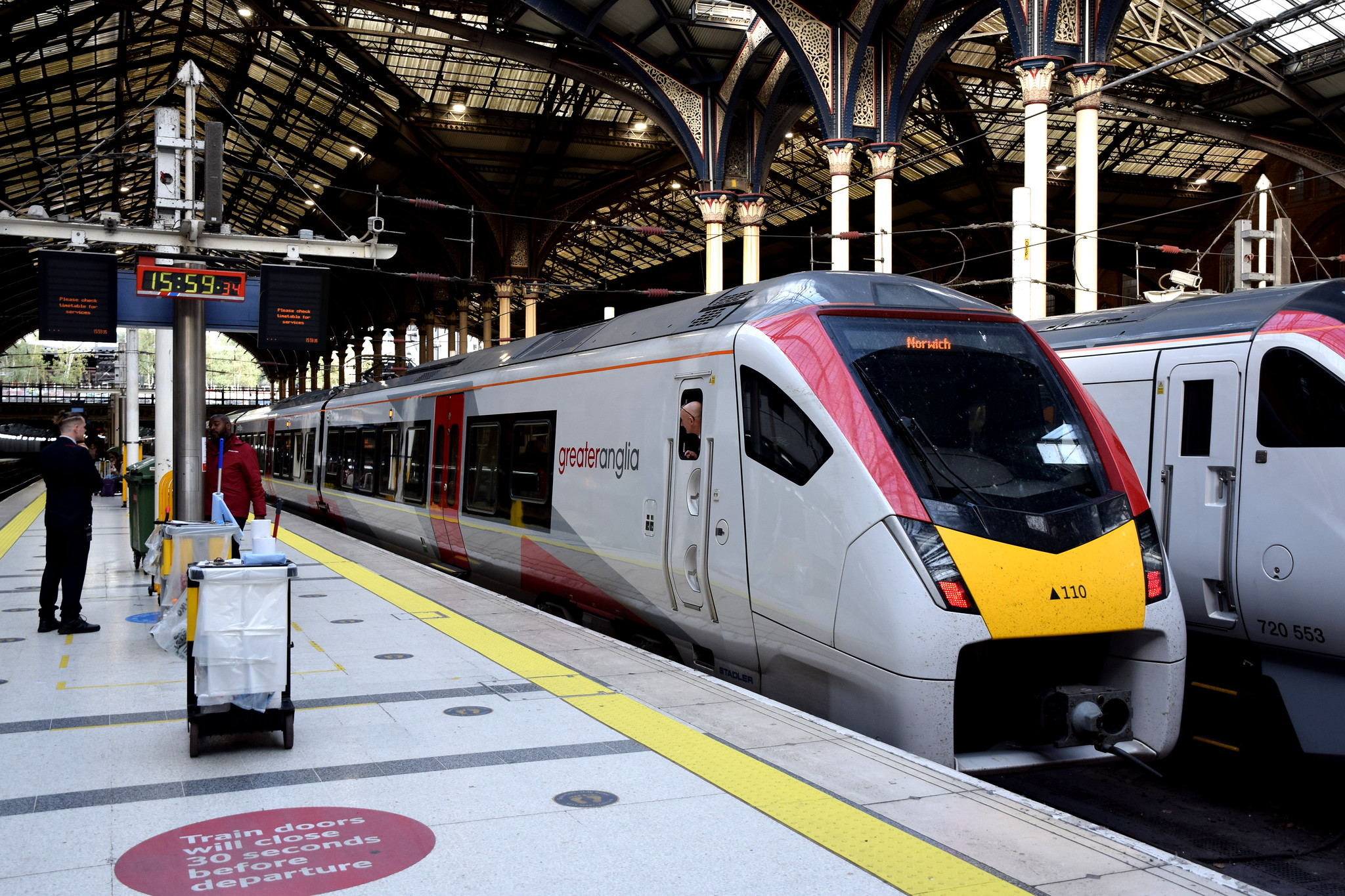 Example 1. A Class 745 Stadler FLIRT stands at Liverpool Street Station. Hugh Llewelyn CC BY-SA 2.0 Deed.
Example 1. A Class 745 Stadler FLIRT stands at Liverpool Street Station. Hugh Llewelyn CC BY-SA 2.0 Deed.
In example one, we can see a Greater Anglia Class 745 train at London Liverpool Street. You're probably wondering how this train is in any way special. It's not really. The 745 is part of the "FLIRT" Fast Light Intercity and Regional Train family from Swiss manufacturer Stadler. An unremarkable unit that had (when ordered) over ten years of development in Europe. What's notable about these units can be seen if one takes a look at the doors. Not only are the doors at platform height, they also have a small pop out "gap filler" that bridges the small, but not insignificant gap between the train and the platform edge. Compare this to the the unit in example two. Example two's unit is a Class 321, a unit made by British Rail Engineering Limited and is representative of a vast majority of UK mainline rolling stock in that it's floor height is wildly higher than the platform height, forcing passengers to have to step up from the platform onto the train.
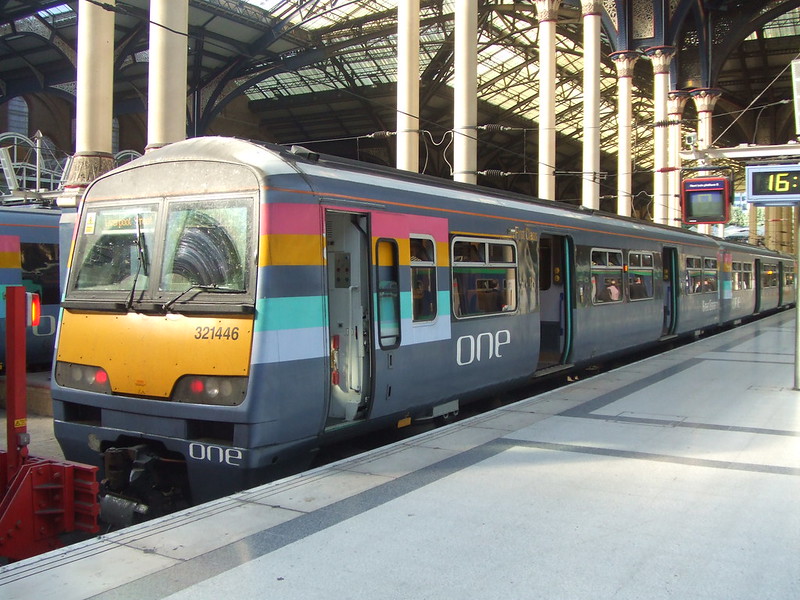 Example 2. Hugh Llewelyn CC BY-SA 2.0 Deed.
Example 2. Hugh Llewelyn CC BY-SA 2.0 Deed.
Why Low Floor and Level Boarding matters
Firstly, a step up immediately makes the train less accessible, or completely inaccessible to some passengers. Users of wheelchairs now require the deployment of a boarding ramp by a member of staff. Not only does this remove their independence, it also has the other issue of creating a ramp that a wheelchair user has to negotiate, sometimes with help. This removes their ability to independently use the railway. Furthermore, most companies require a user to phone ahead and book "assisted travel" in advance (sometimes by as much as 24 hours), or turn up wildly early to board. Examples from Greater Anglia, Southern and Avanti West Coast. One should also consider those who are less mobile, but are not wheelchair bound. While they may not require a ramp to board, stepping up onto the train can be difficult with a walking stick, arthritis or with general frailty. Shorter individuals (as well as children) can also have difficulty negotiating the step up. Individuals with luggage, push chairs, bikes and all sorts of other miscellanea can also find this step challenging. When combined with a curve, or worse, superelevation, this can make boarding a train impossible. As activist Tom Walker says, "it's the environment that disables us" - referring to how the built environment makes disabilities, not the condition(s) that someone may have. 'Disability is not a misfortune - it's the environment that disables us' - Liverpool Echo, Archived Copy The images above are both taken at Liverpool Street Station in London, where the platforms are (mostly) straight and built to spec. We will return to these issues later.
The next question is one of safety. The step up to board the train has instantly caused an obstacle for all users. While one could argue that the step up is small (around 14 cm), it is still a step up. The Rail Accident Investigation Branch (RAIB) has made a great deal about this in an independent report, highlighting three incidents relating to the PTI. Summary of learning - 3. Managing risk at the platform-train interface, Archived Copy The independent Rail Safety and Standards Board (RSSB) also highlights the risk of the PTI on their "PTI Hub" website, stating that 13 fatalities a year are caused by the PTI. Platform Train Interface, Archived Copy They also state that the PTI contributes to 48% of the risks that can cause a passenger fatality. One can argue that level boarding would do little to reduce the risk. Most incidents that involve the PTI are a result of the gap between the longer car body and platform edge, rather than at doors. However, one should consider why that gap is so large. Even more damning, RSSB research into platform-train gap filling devices indicates that enabling a level boarding solution would have a significant impact on reducing the number of major and especially minor injuries that come from the boarding and alighting process. Final Report T1054 - Evaluating Platform Gap Fillers to Reduce Risk at the Platform/Train Interface Technical Summary Report, Requires RSSB Login (free).
The final question is one of efficiency. RSSB research once again finds in favour of level boarding. As part of a 2017 knowledge brief, it was found that "eliminating the vertical step" when boarding a train was a significant factor in reducing platform dwell times - the time a train sits in a platform to board and alight passengers. With shorter dwell times, more trains are able to run on the same track. The Japanese Shinkansen is one of the best demonstrations of this. In this amazing video titled "TOKYO SHINKANSEN RUSH", 16 car intercity trains are seen to arrive and depart at Tokyo station at 4 minute intervals. While there are many factors at play here, it is notable how, despite the menagerie of types, every train features level boarding and (as seen in this video) passengers do not hesitate at all when boarding and alighting from services. Compare this to any UK intercity train and the results are not favourable. Looking at London Euston on a typical day for an hour, Avanti West Coast (the sole operator of intercity services) manages a pathetic nine timetabled departures. Search conducted on RealTimeTrains using advanced search with the following parameters: Station - EUS, Custom Time, 1500-1600, Date 13/06/2024, Operator: VT - Avanti West Coast. View an archived copy of this search. Not a single one features level access, forcing up dwell times at stations. The Shinkansen service operating on a 4 minute interval manages around fifteen an hour (a 66% increase in departures) and this ignores any other regional services that may run between Tokyo and Osaksa. It is important to note the atrocious service that Avanti has become famous for is not just a question of level boarding and is instead the poster child for the issues that three decades of fragmented and outdated policies that have regulated the privatised railway system that passengers are forced to confront every time they attempt to make a rail journey.
What do the Standards say?
While there is no standard within the RSSB's catalogue governing the floor height of passenger vehicles, there is a standard that governs the height of platforms on the network. GIRT7020 "GB Requirements for Platform Height, Platform Offset and Platform Width" sets the standard for platforms across the mainline network Note that London Underground and other non-Network Rail systems are free to set their own standards. states the following:
For new platforms and alterations (as defined) to existing platforms, the design height at the edge of the platform measured perpendicular to the plane of the rails shall be 915 mm (within a tolerance of +0 mm, -15 mm), except for platforms where defined legacy rolling stock is permitted to operate. GIRT7020 Iss 2 - GB Requirements for Platform Height, Platform Offset and Platform Width, Requires login with RSSB (free).
So there is a standard that operators and rolling stock manufactures can adhere to. Do remember, however, that a good portion of the UK mainline network does not meet this standard, for many reasons. Worse still, there is no rolling stock manufacturer in the United Kingdom offering passenger rail vehicles with floor heights that adhere to this specification. Of the offerings from Alstom (Aventra Class 345 Data (Archived Copy) and Coradia), Siemens (Desiro City Desiro City Thameslink, Desiro City SWR (Archived Copy), Desiro City Moorgate(Archived Copy) ), Hitachi (Commuter and Intercity) and CAF (Civity UK), none are currently offered with a floor height of 915mm. This is particularly egregious from CAF and Siemens, who both make low floor (and even advertise low floor Civity, a family of trains for commuter and regional services - CAF (Archived Copy) ) rolling stock for mainland Europe. The failure for platforms and rolling stock to meet this standard has several negative impacts on the passenger experience, as well as on the safety of the passenger. Sadly the status quo is perfectly legal as the RSSB is an industry body and has no legal powers to enforce it's own standards.
A Regulatory Diversion
It is important to note, before continuing, that level boarding is not a requirement under the law for the National Rail network. The most relevant legislation that applies is the European Union's Persons with Disabilities and with Reduced Mobility Technical Specifications for Interoperability (PRM TSI); while the UK has formally left the European Union, due to the European Union (Withdrawal) Act 2018. European Union (Withdrawal) Act 2018 (Archived Copy) This does not mean that we should not be striving for level boarding, for reasons that will be outlined shortly.
In comparison, systems that are not designed to be interoperable - such as trams and metros - are bound by a different set of regulations - the Rail Vehicle Accessibility Regulations (2010) (RVAR). RVAR applies to systems such as the London Underground or the Tyne and Wear Metro and the regulation is a lot more stringent than on the National Rail network. No platform height is specified (as RVAR can apply to trams as well as metro systems), however a specification does exist for the maximum step and gap permissible. Passengers should not be expected to negotiate a gap of 75mm horizontally and a step no greater than 50mm vertically. This equates to diagonal distance of 90mm, if my trigonometry is right. If the maths is wrong here, I am very sorry to Mr Hatch, who taught me trig.
Mixed Traffic - A Complicating Factor
The alternative question to ask is "why isn't the fixed infrastructure built with higher platform heights?" This solution has been taken in some cases, the most notable being on Crossrail (also known as the Elizabeth Line), where platform heights are at the 1100mm floor height of the Class 345 EMU's operating the service. it is therefore natural to conclude that this is the much simpler solution - passenger trains floors are traditionally 1100mm above railhead, so why not just make the platforms that height. The problem is the mixed traffic nature of the UK railways.
The UK railways are in the unenviable position of trying to not only provide for the ever increasing passenger demand, but also for the demand of freight. Freight operations impose some restrictions on the passenger network, the most notable being the demands for the largest vehicle dimensions wherever possible. This is demonstrated perfectly by the shipping container. As is noted by the RSSB, most container traffic (and freight traffic for that matter) can only run within the "W10" loading gauge, with W6a gauged wagons. Within the context of level boarding, this means that the platform height has to conform to the W6a loading gauge to ensure that freight can also move around the network unimpeded. Gauging - The V/S SIC Guide to British Gauging Practice (archived) This is one of the influences into that standard 915mm height, 730mm offset from the rail head defined in GIRT7020.
So why did Crossrail go for 1100mm platform heights? I've not been able to find anything particularly concrete, most certainly nothing from within the Government, TfL or Crossrail, however it would appear to be due to a willingness to ensure that a UK based manufacturer was able to win the contract. Crossrail tender favours UK, Archived copy unavailable due to limits on Web Archive. See the archive attempt. Bombardier's (now Alstom's) "Aventra" platform (the market name for the train type that Bombardier supplied to Crossrail) is an evolution of the Electrostar platform. From the archives: Mind the generation gap, Archived Copy The Aventra is not a re-design, nor is it a new design. While no EMU in the modern era is a truly new design, it is very clear that the Aventra was, at one point, an Electrostar. As a result, it has inherited one of the biggest faults with the Electrostar - the floor height. Crossrail wanted to have level boarding and the train they were getting would not have a 915mm floor height - so the core platforms got raised, to the determent of users in the outer regions. The decision was also been heavily criticised by the London Assembly Transport Comittee in 2018. Pidgeon slams Crossrail for non-standard platforms, Archived Copy Quoting directly from RAIL 858:
A Department for Transport spokesman told RAIL that Crossrail did not receive a derogation to build the platforms at a different height to the national standard, but confirmed that the Secretary of State of Transport issued a dispensation under Regulation 46 of the Railways (Interoperability) Regulations 2011 in order to build the platforms higher. This meant neither the Office of Rail and Road nor Transport for London needed to be consulted about the change. Ibid.
Heading back to the contract issue, Siemens of Germany won the Thameslink fleet renewal contract causing Bombardier to cut it's staffing just about in half (1500 jobs cut of 2800 total) significantly downsizing one of the few UK train factories. The Government at the time (under the Leadership of David Cameron) saw this as unacceptable and took steps to "level the playing field" for manufacturers in the UK, of which Bombardier was the only realistic company. Crossrail tender favours UK, Archived copy unavailable due to limits on Web Archive. See the archive attempt. As a result, Crossrail (well Elizabeth Line) passengers lost out due to the Government prioritising a UK company over delivering a good solution. Rather irritatingly, the links to read the tender as provided in TfL's FOI on the matter are now dead and not archived on the Web Archive (thanks, link rot!). TfL FOI-1437-2021 (Archived copy) Rather ironically, this was effectively for nothing due to the boom-bust cyclic nature of UK rolling stock purchasing habits. Disjointed rail planning leaves UK train builders facing closure, See previous FT article for why there is no archived copy.
Case Studies
London Underground
Another case study worth considering is Transport for London, in particular the London Underground network. LU's network consists of many lines and stations built up over the past one hundred and sixty years, some in original condition and some, such as Battersea Power Station, opened less than three years ago. Northern line extension: Two new Tube stations open (Archived Copy) Not only does this provide a diverse range of infrastructure to examine, LU also has a diverse selection of rolling stock, with the oldest active (passenger carrying) trains being originally introduced in 1972 (1972 Bakerloo Line) London Underground Rolling Stock Information Sheets - 1972 Stock (Archived Copy) and the newest arriving between 2010 and 2017 (Subsurface S8 and S7). London Underground Rolling Stock Information Sheets - S8 Stock, Archived Copy In many ways, LU offers an amazing insight into how approaches to level boarding and passenger comfort have changed.
Please note, the measurements for LU vehicles have been taken from the London Underground Rolling Stock Information Sheets - 1972 Stock(Archived Copy). Due to the varying ages of the vehicles discussed here, there will be a mixture of imperial and metric units. Imperial units will be converted to the now industry standard metric system where apropriate.
Let us first begin with the 1972 Stock. While these trains are very charming, especially on the inside (I had a first date going out bashing Bashing is a slang term used by enthusiasts and others to describe the activity of attempting to ride on/behind a particular vehicle or type. these, very sad, I know), they are most certainly of the inaccessible variety. Being built and having their refurbishment in an era where designing for accessability was still an emerging concept on the railway, these trains are less than ideal when it comes to accessibility. This is not to say that attempts were not made; as with nearly all 1990's and early 2000's rail interiors, ample room is provided for wheelchair users and a comprehensive system of grab bars are installed. However, these trains (and the closely related 1973 Stock of the Piccadilly Line) suffer greatly when it comes to the Platform Train Interface, especially within the portion of the Bakerloo that runs along the Watford DC lines.
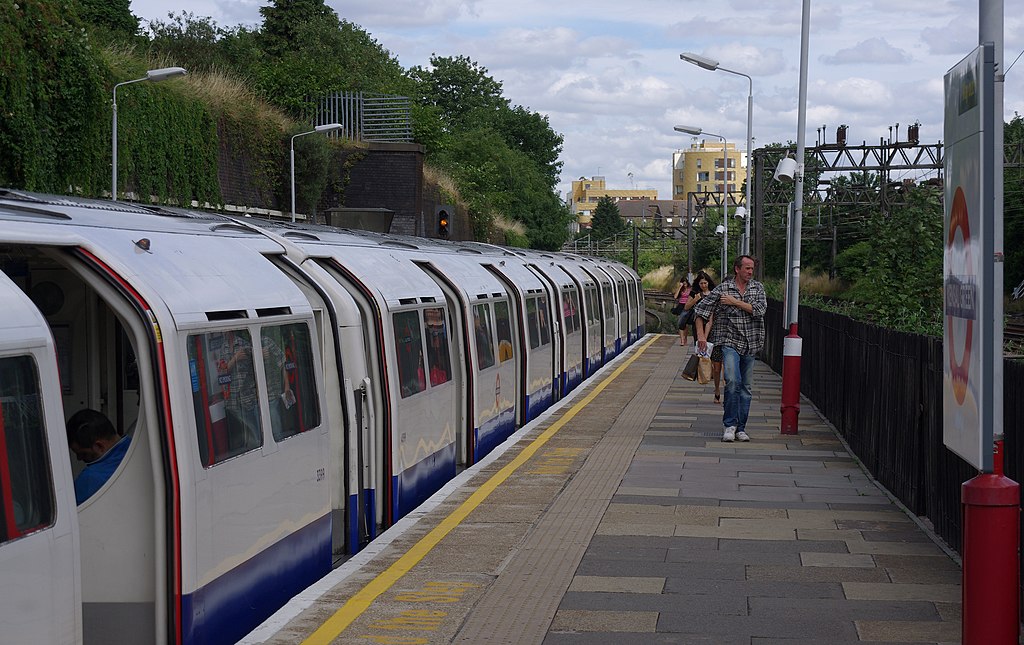 1972 Stock train at Kensal Green Station. mattbuck, CC BY-SA 2.0, via
Wikimedia Commons.
1972 Stock train at Kensal Green Station. mattbuck, CC BY-SA 2.0, via
Wikimedia Commons.
The Watford DC, being Network Rail territory has GIRT7020 platforms (or near enough to). Sadly no official TfL documentation in the public domain (that I can find) publishes the floor height of the '72 stock, however Tubeprune (The Tube Professionals Rumour Network) states that the '72 stock floor height is 756 mm. LU Rolling Stock Dimensions (Archived Copy) This creates what can only be described as the worst possible conditions - a step down into the train. A step of 135 mm (13.5 cm!). You cannot put a ramp up (or down) in this situation. Furthermore, the trip hazard is huge - anyone with any sort of mobility problem is going to find this difficult to impossible to navigate, made worse by the fact that 1972 stock trains do not have any grab bars inside the doors to help people steady themselves. It is amazing that this is even permitted to run by London Underground and National Rail. What's even worse is that the alternative, "accessible" service is run by London Overground's Class 710 units (of the Alstom Aventra family) have high floors and require ramps to be accessible! The final insult for passengers here is that within the underground section, 1972 tube stock over-sails the platform edge, meaning that the floor height is higher than the platform. S1156 A11 Gauging and Clearances (Archived copy) They are not compliant to any standard, yet are allowed to run due to the grandfather rights in RVAR and as a result make the Bakerloo Line one of the most inaccessible railways in current operation within the UK.
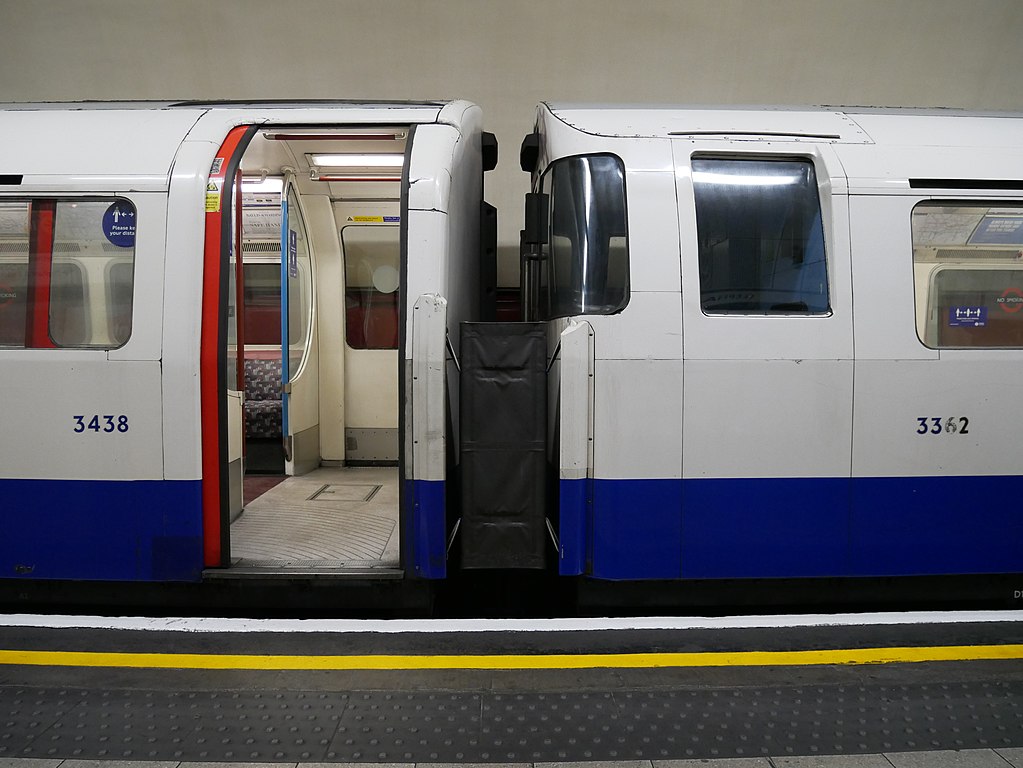 1972 Stock Train at a tube-level platform. citytransportinfo, CC0, via Wikimedia Commons.
1972 Stock Train at a tube-level platform. citytransportinfo, CC0, via Wikimedia Commons.
By comparison, the S7 and S8 (from this point forwards, S stock) are much better than previous units for level boarding. With a floor height of 1002 mm, these units are much more suitable for the network that they run on. It is very important to note that while the floor height of these units is 1002 mm, the height of the floor/tread plate at the entryways is only 980mm or just over a 20 mm (two centimetre) drop. These units have a very visible slope from the main floor down to the doors, as seen in this image.
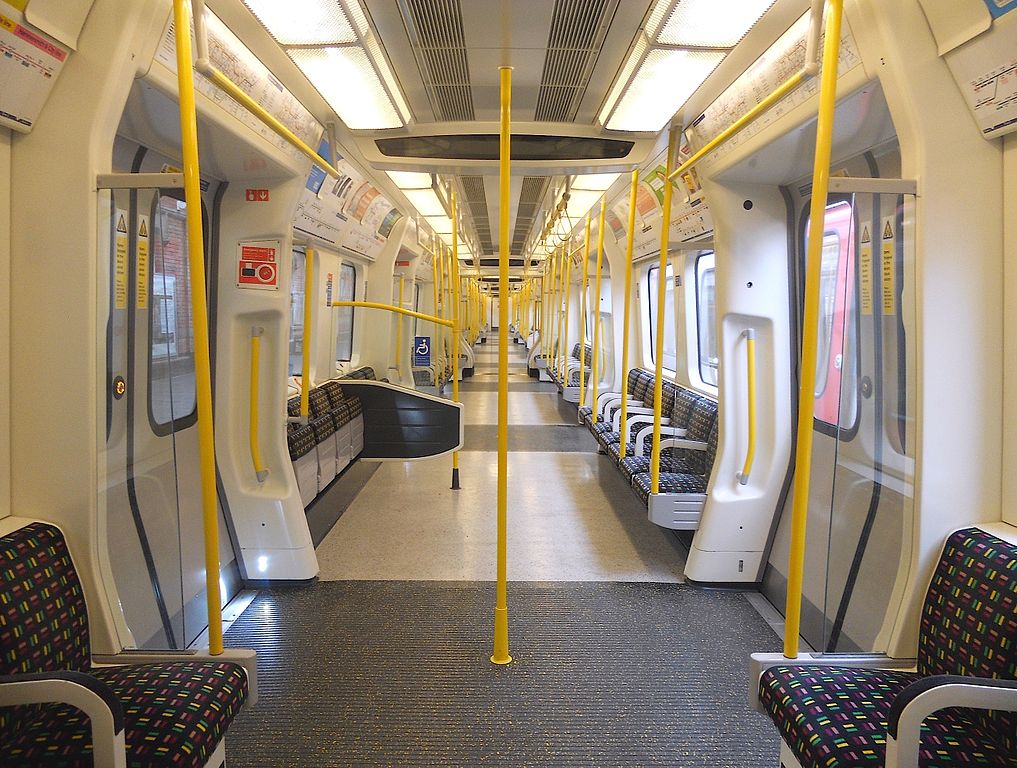 Interior of S Stock. Note the gentle slope from the main car floor to the door tread plates. PeterSkuce, CC BY-SA 4.0, via Wikimedia Commons.
Interior of S Stock. Note the gentle slope from the main car floor to the door tread plates. PeterSkuce, CC BY-SA 4.0, via Wikimedia Commons.
As per RVAR (Rail Vehicle Accessibility Regulations), the S Stock is well in compliance with the platform-train gap. As per the TfL LU Standard S1156, the platform edge height is 950 mm ARL, while as we note above, the S Stock doorways are 980mm. While this is 30 mm (three centimetre) maximum step, it is as good as level. S1156 A11 Gauging and Clearances (Archived copy) Wheelchairs users, rolling luggage, prams etc. all are easily able to navigate the step and even for those who are not as mobile or have vision impairments, the step is well within a safe margin.
The Platform Train Gap (on TfL)
Even when the platform height and train floor height are equal, level boarding is still not a guarantee. Due to various factors, including age, challenging conditions and space constraints, many stations are not built in the "ideal" position - on a straight alignment. Instead many are built on curves or are built with increased clearance either for a designated reason or due to grandfather rights. As a result, even when trains may otherwise have level access, they are still inaccessible due to the lateral gap.
There are many proposed solutions to this problem. One of the most common solutions is unfortunately the continued use of some sort of ramp or "bridging device". One of the larger deployments of this equipment is on the TfL Tube network, where they are are known as "Mini Ramps". Mini Ramps (Archived Copy) You can see one in action by watching this publicity video TfL produced on YouTube. These are a good stop-gap solution. While they do not require the replacement of otherwise perfectly serviceable rolling stock, they do not solve the problem that a passenger will still need to pre-arrange their use, removing the independence of a passenger. TfL are notable, however, for offering this as a "turn up and go" service, rather than the pre-arrangement that is common on National Rail. Quoting directly from their "Wheelchair access & avoiding stairs" webpage: Wheelchair Access & Avoiding stairs (Archived Copy)
As part of our turn up and go service, staff at your departure station will be happy to arrange for you to be accompanied to the train if you wish and met by a member of staff at your destination and any interchange stations.
They can also help lay down a boarding ramp or mini ramp if you wish to use one.
If you are using a boarding ramp or mini ramp to get on or off the train, the member of staff will lay this down for you and ensure it is safely in place.
It's very positive that this is offered as a turn up and go service. While passengers are not fully independent, they are able to make their trips relatively pain free. TfL promise that staff are well trained and the offer of accompaniment without pre-arrangement is also amazing, as it can offer some passengers a sense of security when accessing a difficult to access system.
Things are looking up for TfL. As noted in the New Tube for London Feasibility Report New Tube for London Feasibility Report - October 2014 (Archive Copy) , a platform based gap filler prototype has been commissioned in as part of the NTfL project and has been a resoundingly successful and robust unit. We will take a look at these devices in more detail anon. Sadly I cannot find any indication as to if these units will be installed when the Piccadilly Line is closed later this year for modifications to enable the 2024 Tube Stock to run. Piccadilly Line Closure (5) Here's hoping that the gap fillers will be installed, as it is one more step to making the network accessible.
Wolverton Station
One of the most egregious stations on the National Rail network, Wolverton is a textbook case of how not to do level boarding. While I have not personally measured the station, the following photos demonstrate just how atrocious the station is. Measuring roughly using the distances between the wheels as a known distance (2600mm on the SF 500 bogies), we can guess that the vertical step is greater than 40 centimetres at least. What makes this worse is that "General Access Stairs" (staircases in public buildings) should be no greater than 17 cm tall, yet exceeding this more than two times is apparently alright on public transportation. Stair Regualtions in the UK - Buildsafe (Archived Copy)
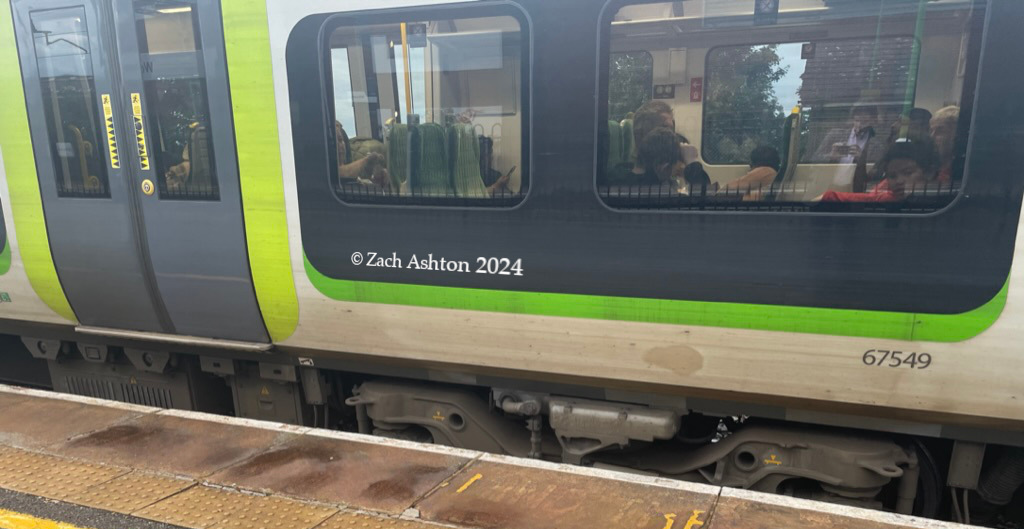 Wolverton Platform Train Interface. Photograph by me. All Rights Reserved.
Wolverton Platform Train Interface. Photograph by me. All Rights Reserved.
While I am not a gym enthusiast (or a gym user for that matter), I am not an unfit person. Yet even I struggle to use the platforms at Wolverton. I'm a little taller than the average UK male. Health Survey for England, 2021 (Archived Copy) If I struggle to use the platforms that indicates that the average person in the UK will find Wolverton station difficult to use. Compound this with the factors in favour of level boarding (luggage, push chairs, poor mobility, wheelchairs, etc.) and you have one of the least accessible stations on the network (ignoring the complete lack of lifts).
Update (17th June 2024)
I put in an FOI request to Network Rail as part of the second part of this. I was able to locate the location of the photo of the Class 350 at Wolverton to be closest to the 52 miles 42 chains and 4 yards (from Euston) datapoint for Wolverton Platform 3. The platform height at this datapoint is a shockingly bad 672mm (243mm from the standard) It's further compounded by the 115 mm of cant (superelevation), causing the train floor to be at something of an angle making boarding and alighting even more difficult.
Intercity Rail
In this final case study, we will interrogate the state of intercity rail in the United Kingdom. We will take a look at two generations of rolling stock - the late 90's/early 2000's era of "early privatisation" and the mid to late 2010's and newer "modern" units. Not to spoil the conclusion, but there is only one intercity train in frontline service that does this right.
We shall start with the Class 222 - an early privatisation train from Bombardier that began to appear on the UK railways in 2004. Class 222 | Eversholt Rail (Archived Copy) These are sturdy units with a strong "thousand's vehicle" vibe to them; you know, the slightly aggressive and speedy looking with lots of aerodynamic rounding, spoiled by the great big mouth for the coupler that makes it all look a little bit silly. The Class 222 is emblematic of most of the UK "High Speed" High speed is a difficult term to define. The UK has a "high speed" network, as defined by classic lines being upgraded to 200km/h (125mph) running, but has little of modern high speed (250km/h, 155mph) infrastructure outside Kent and has no domestic > 255 km/h (140mph) service. fleet from this time, being built with large wheels, high floors and requiring a small step to board. These trains are about as difficult to board as you could make them.
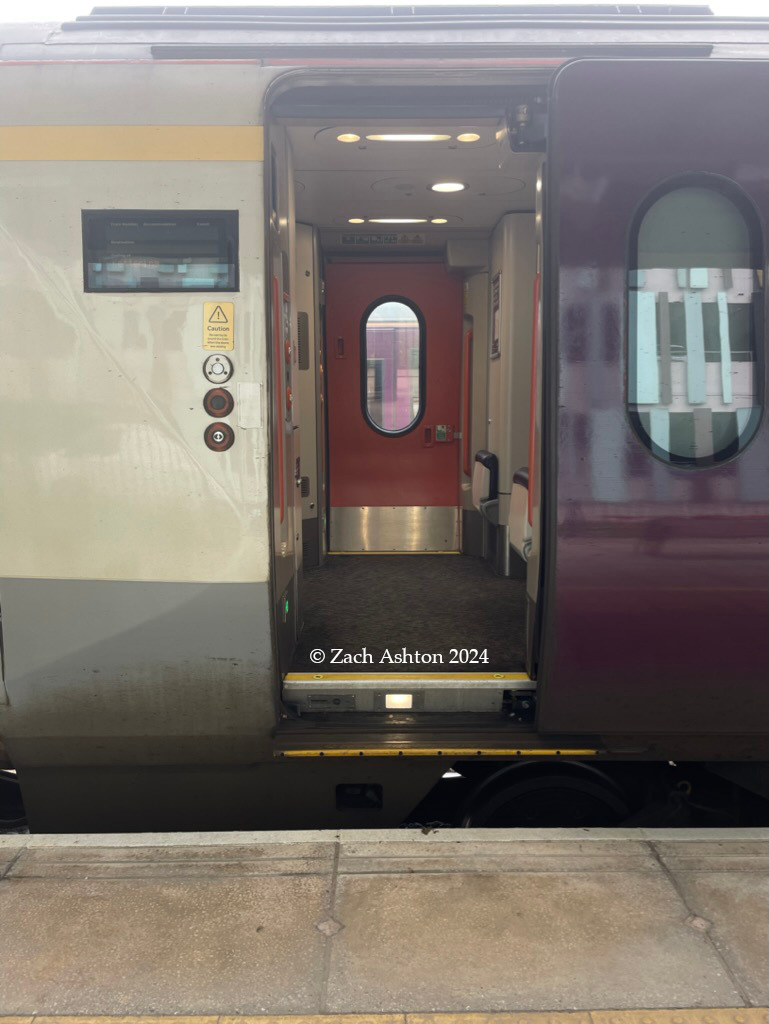
Class 222 Entryway. Photograph by me. All Rights Reserved.
Unfortunately I don't have a floor height for these trains (searching for anything to do with the 22x family is particularly difficult when they use names like "Voyager" and "Meridian"), however it is very clear that these trains have an even higher than usual floor height. This is less of an issue on an Intercity train, where stops are infrequent and dwell times are long, yet it does not move away from the requirement for staff to help wheelchair users. The extra step also makes these trains vastly more difficult for passengers with luggage, who have mobility difficulties or who just don't feel amazing. It is understandable why rolling stock makers want a high floor for intercity trains; higher floors allow for bigger wheels which means a more comfortable, smooth and efficient ride for passengers. There are ways to have large wheels and low floors (which we will get to) but first we must address the Class 80x family. Despite the high floors on older intercity stock being a known issue, the latest 80x fleets that supplement and replace older intercity fleets in the UK are still built with a step like that on the 222. Entering service in 2017, the "Intercity Express" still fails to be designed to fit the platforms it operates to and from. What's worse is that Stadler Rail had already designed and taken orders in 2008 for a train that would have been to the correct height, only it was for the Norwegians. FLIRT200 - Stadler Rail (Archived Copy)
In 2016 something of a miracle happened. A UK train operator ordered rolling stock that would fit the standard platform. As part of the awarding of the East Anglia franchise, the new operator (Abellio) was to order and move to a new fleet of trains as part of their franchise agreements. Stadler and Bombardier to supply trains for Abellio East Anglia franchise (Archived Copy) While Bombardier won the contract to supply commuter trains (based on their already discussed Aventra platform), the Swiss firm Stadler Rail won the contract to replace the aging MK3 passenger coaches (and associated locomotives), as well as supply new regional trains. Stadler signs largest UK order with Abellio East Anglia and Rock Rail (Archived Copy) The result was the best train in UK rail history for being an accessible train for all. The Class 745 electric and 755 hybrid diesel/electric units are a breath of fresh air and show what can be done on the railway. Alongside the usual modern day accoutrements the 21st century traveller would expect (air conditioning, good seats, good lighting, plug sockets, etc.) these units also feature level boarding! Not only are their floors at that magic 915mm height, they also feature little platforms that pop out and fill the gap! These little devices appear in most of Stadler's new trains and are such a simple yet brilliant solution. The 745 fleet in particular is a great demonstration that high speed rail in the UK need not compromise accessibility. Furthermore, larger wheels are retained on these trains - in some areas the floor is raised a little to make room for the bogies, much like on a tram. A neat detail that most passengers probably won't even notice, but ensures the trains are fit for all to use. The doors and gap filler sequence of a FLIRT can be seen in this YouTube clip.
Solving the Problem
Solving the level boarding problem is not an easy task, nor will it be a quick one. As we have seen, the lack of level boarding is one that is baked into much of the British Railway Infrastructure. However, progress can be made. We can break the problem down into two major categories. The first is the fixed infrastructure - platforms, permanent way, buildings and so on. The second is the rolling stock.
Infrastructure
The infrastructure problem is most certainly the most difficult to fix. Physical assets are expensive to build, maintain, repair and modify. Furthermore, ensuring they do not encroach the dynamic envelope of the railway is time consuming and expensive. I do not have any easy solution for this, beyond engaging in a rolling programme where a team (or teams) works on re-building platforms (on Network Rail) to GIRT7020. There are, however, issues with rebuilding all platforms to GIRT7020. While the height is standardised and the position in relation to the railhead will be, it does not address the issue of platforms on curves. While in some cases it may be practical to move platforms to straights, the reality is that much of the network cannot be rectified. This is where a debate arises about gap filling, which will be discussed anon.
Rolling Stock
Rolling Stock is a much simpler question, in my mind. While it is difficult to impossible to re-engineer existing stock to have a lower floor height in compliance with the platform height specified in GIRT7020, new stock can have requirements placed to enforce a lower floor height. We know from Europe that trains can be built with low floors; the UK even has multiple examples of excellent low floor designs from Stadler in operation (as of the date of publication). The issue is that a majority of rolling stock platforms being sold in the United Kingdom are not compliant, with high floors that create a step up.
Right now, we have a stop gap solution - the platform boarding ramp. While this is an amicable stop gap solution, even potentially a much more long term solution as TfL has demonstrated, it is not a long term solution. Reliance on staff makes the railway inaccessible. As I have stated before, we should not be removing staff from the railway. Platform and on train staff are key to ensuring a safe and welcoming passenger experience, however they should not be forced to have to operate heavy, cumbersome boarding ramps to enable people the basic right of access to transportation. Staff should instead be prioritising the safe operation of the train, not wasting their time on operating a system that really should have never been required.
Platform Train Gap Fillers
The Platform Train Gap Filler is a really interesting solution to the lateral gap problem, especially at curved platforms. The principle is simple - provide a platform that bridges the gap between the train and the platform edge that is deployed (often automatically) on the arrival of the train. This is not the same as the TfL "Bridging Device", which we have classed as a variant on the boarding ramp. Instead these automatic systems work without the requirement for staff to meet an arriving service. There are two main varieties of the gap filler - the train-bourne and the platform-bourne device. Both have a long history of usage and have their advantages and disadvantages.
Devices fitted to the platform
Platform-bourne devices appear to be the older and much more tested method of achieving level boarding. There's a couple of types of platform based filler that have come to market depending on the solution required, a mechanical solution and a purely passive one. The mechanical ones have a much longer history with the earliest example I can find being the ones fitted to the New York's Subway at 14th Street-Union Square station. You can see them in operation in this great video. In this model, a mechanism extends a grating into the gap between the train and platform edge, plugging the hole and providing safe access to the train.
The obvious downside is that these devices are mechanical and are directly under millions of travellers feet a year. Newer models are maintainable from the platform (not requiring the railway to be closed and people put in danger to maintain them) which can somewhat mitigate this problem. The other, much more serious downside is that a failure in the extended position would prevent a train from departing or could lead to the gap filler being in the path of an oncoming train. This is not an acceptable failure. Closed systems like the New York Subway or the London Underground can mitigate this by interlocking the doors with the gap filler as they only operate one or two types of train to the platform(s) in question. On Network Rail, this is difficult to impossible, due to the menagerie of different train types in operation. For trains on Network Rail's tracks, the second type of gap filler is a much better fit.
Devices on the train
As we have already seen, solution offered by Stadler on their FLIRT design (as well as on their Class 777 METRO fleet for MerseyRail). The gap filler is a great solution to the horizontal gap. It's adaptable to each platform (as sensors control the extension) and doesn't require any infrastructure changes beyond ensuring that the platforms meet GIRT7020. Unlike platform based devices, these gap fillers can fail in a way that still allows other trains to use the station as they can be manually retracted and the door locked out of use, rather than failing and potentially being in the way of oncoming traffic. Furthermore, at worst a single unit is out of use. They can also be combined with other small changes, such as the wedges seen on the 777 units prevent people from falling into the gap away from the doors, a decision taken in the wake of the St James St. incident. Report 22/2012: Fatal accident at James Street station (Archived Copy)
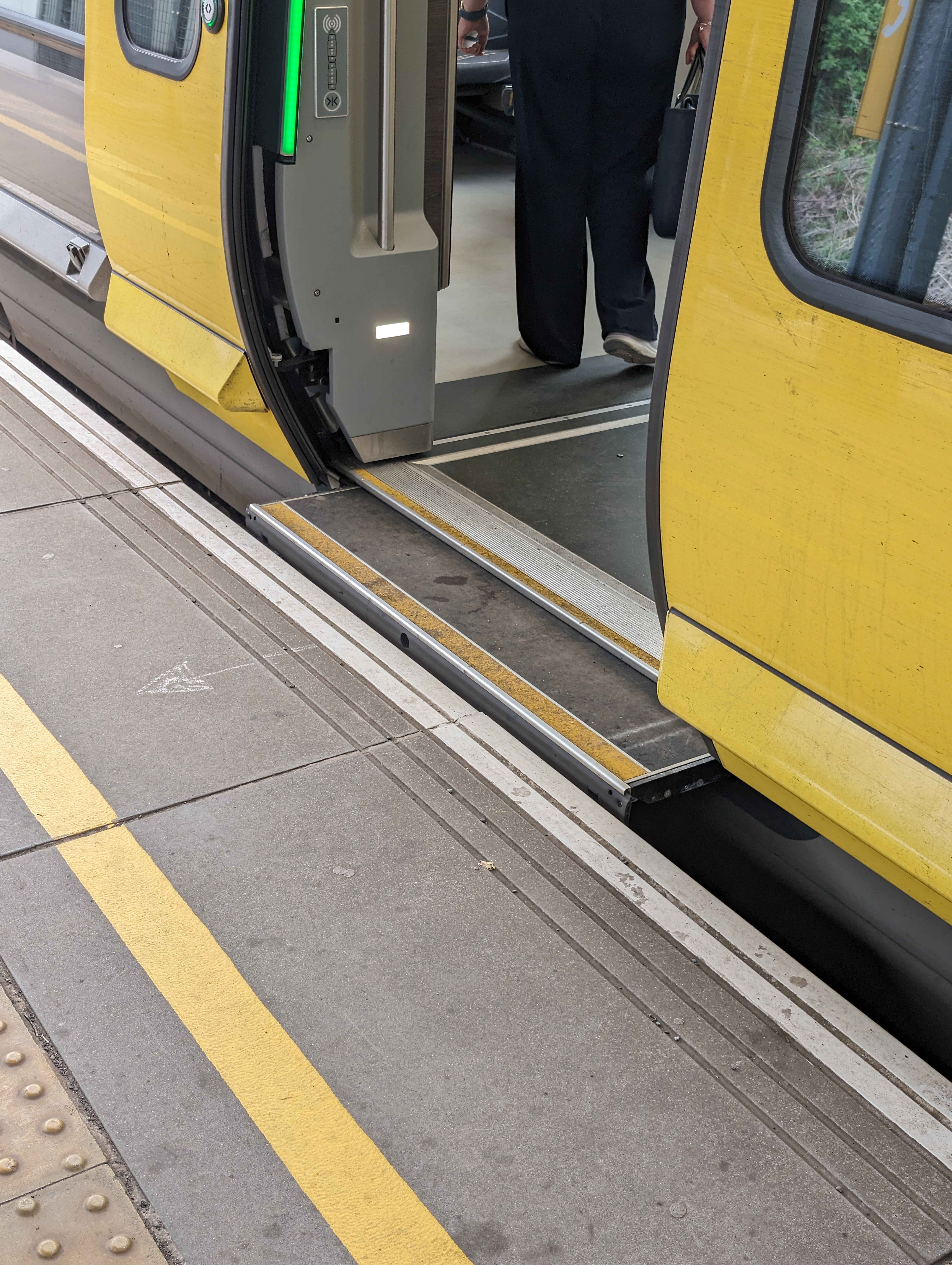 Class 777 (Stadler METRO) Doors with Gap Filler. Photograph courtesy of Arturs Dobrecovs.
Class 777 (Stadler METRO) Doors with Gap Filler. Photograph courtesy of Arturs Dobrecovs.
See a gap filler in action on a MerseyRail Class 777
Concluding Thoughts
Level boarding is not an impossible thing to provide. It requires coordination and planning, but can be provided in the long term to better enable travel for people. The safety, speed and accessibility benefits make level boarding, in my opinion, a must have for the modern railway. It is a real shame to see new trains (such as the Aventra family) having been ordered and put into service without level access provisions. Worse still, Crossrail has demonstrated how poorly the United Kingdom thinks about railway infrastructure and access for all as those outside the core stations between Paddington and Abbey Wood have been given an inaccessible train that has seriously injured multiple people. Providing level access with gap fillers would have prevented these injuries.
While the changes to rolling stock and infrastructure won't occur overnight, they can be slowly rolled out. As stations and platforms come up for works and renewals, platform heights and offsets can be corrected to be within the standard. As new rolling stock is ordered, it can be a requirement to have a level floor and gap fillers. If RVAR applies to metros, tramways and the like, it should also apply to the National Rail network. Level access is not just about wheelchair users as it is often made out to be. It is about ensuring that everyone can use the railway, no matter their age, height, mobility requirements or otherwise. Until it is achieved, the railway will remain fundamentally inaccessible and inequitable, entrenching existing inequalities, not only in travel but also in economic and social prospects. Pogonyi, Csaba G. 2020. “The Wider Economic Benefits of Transportation,” in Advances in Transport Policy and Planning, pp. 129–64
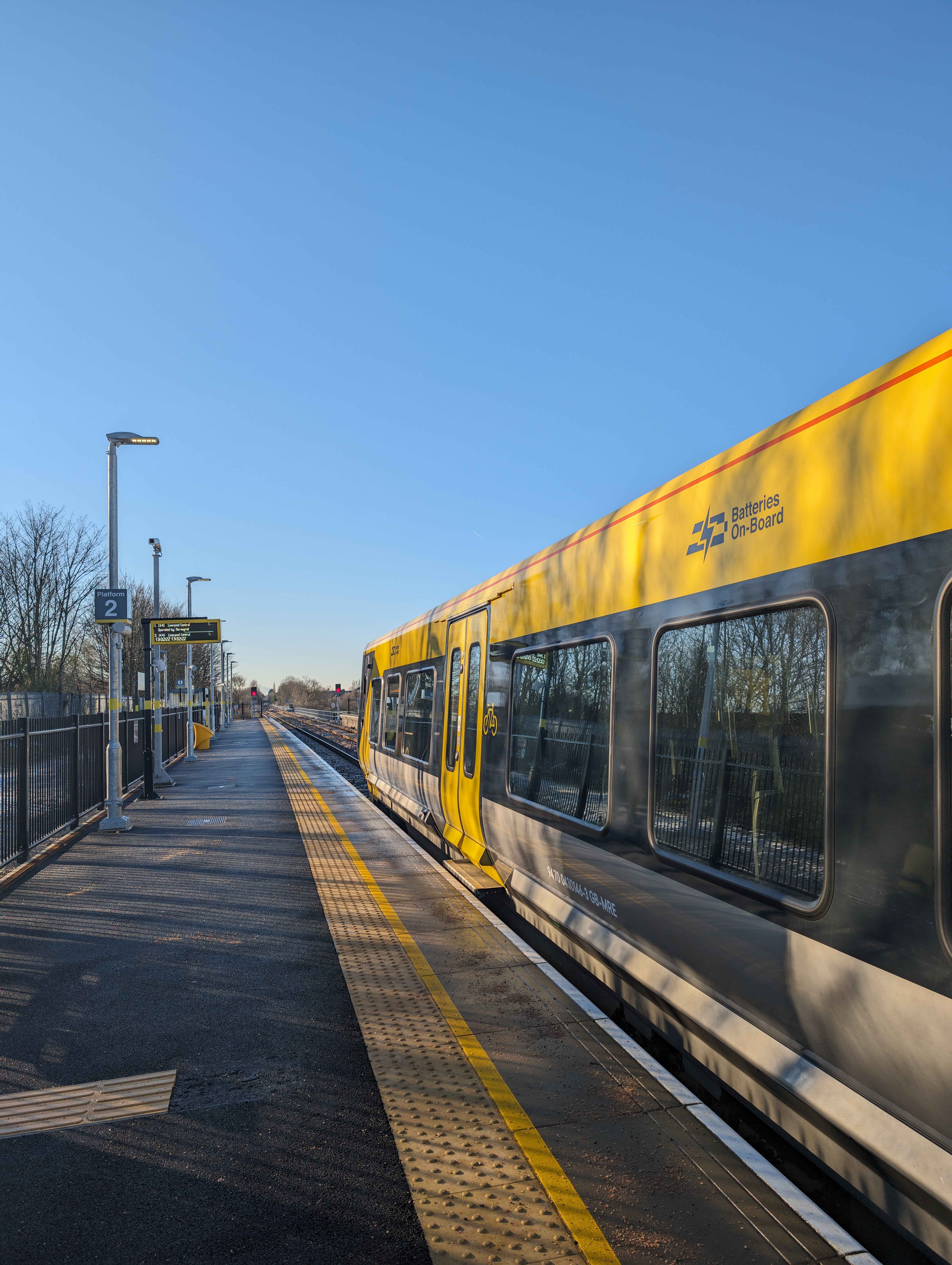
Acknowledgements
This piece would not have been possible without the help and expertise of Gareth Dennis and Amir Dawoodbhai. MerseyRail Class 777 (Stadler METRO) photography by Arturs Dobrecovs.
Bibliography
- Assisted Travel examples from Greater Anglia, Southern and Avanti West Coast.
- Summary of learning - 3. Managing risk at the platform-train interface, Archived Copy
- Platform Train Interface, Archived Copy
- Northern line extension: Two new Tube stations open, Archived Copy
- London Underground Rolling Stock Information Sheets - 1972 Stock, Archived Copy
- London Underground Rolling Stock Information Sheets - S8 Stock, Archived Copy
- Mini Ramps, Archived Copy
- Wheelchair access & avoiding stairs, Archived Copy
- GIRT7020 Iss 2 - GB Requirements for Platform Height, Platform Offset and Platform Width, Requires login with RSSB (free).
- Class 345 Data, Archived Copy
- Desiro City Thameslink, Archived Copy, Desiro City SWR, Archived Copy, Desiro City MoorgateArchived Copy
- Civity, a family of trains for commuter and regional services - CAF, Archived Copy
- European Union (Withdrawal) Act 2018, Archived Copy
- New Tube for London Feasibility Report - October 2014 (Archive Copy)
- Piccadilly Line Closure (5)
- S1156 A11 Gauging and Clearances,Archived copy
- Final Report T1054 - Evaluating Platform Gap Fillers to Reduce Risk at the Platform/Train Interface Technical Summary Report, Requires RSSB Login (free).
- RealTimeTrains search for Euston Departures. Conducted using advanced search with the following parameters: Station - EUS, Custom Time, 1500-1600, Date 13/06/2024, Operator: VT - Avanti West Coast. View an archived copy of this search.
- Health Survey for England, 2021, Archived Copy
- Stair Regualtions in the UK - Buildsafe, Archived Copy
- Gauging - The V/S SIC Guide to British Gauging Practice (archived)
- From the archives: Mind the generation gap, Archived Copy
- Crossrail tender favours UK, Archived copy unavailable due to limits on Web Archive. See the archive attempt.
- TfL FOI-1437-2021, Archived copy
- Disjointed rail planning leaves UK train builders facing closure, See previous FT article for why there is no archived copy.
- Class 222 | Eversholt Rail, Archived Copy
- 'Disability is not a misfortune - it's the environment that disables us' - Liverpool Echo, Archived Copy
- FLIRT200 - Stadler Rail, Archived Copy
- Stadler and Bombardier to supply trains for Abellio East Anglia franchise - Archived Copy
- Stadler signs largest UK order with Abellio East Anglia and Rock Rail - Archived Copy
- Pogonyi, Csaba G. 2020. “The Wider Economic Benefits of Transportation,” in Advances in Transport Policy and Planning, pp. 129–64
- LU Rolling Stock Dimensions, Archived Copy
- S1156 A11 Gauging and Clearances,Archived copy
- Report 22/2012: Fatal accident at James Street station , Archived Copy
- Pidgeon slams Crossrail for non-standard platforms, Archived Copy
Changes
Content changes are denoted in bold.
20th February 2025
- Added link to Part Two.
30th September 2024
- Fixed name inconsistencies. For more see the nomenclature page.
17th July 2024
- Added update about Wolverton Station's platforms.
- Added
idattribute#wolvertonto section on Wolverton. - Reformatted posting dates/author locations.
7th July 2024
- Added
target="blank"attribute to all external links to open external links in a new window. - Fixed meta tags (again).
2nd July 2024
- Added Mastodon Link
- Added OpenGraph Meta
- Fixed LU measurements note.
Mobile users may tap on instances of ‡ and citation numbers to view the sidenotes inline.